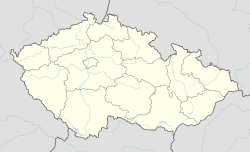Velké Losiny
| Velké Losiny | |||
|---|---|---|---|
| Municipality | |||

Chateau
|
|||
|
|||
| Coordinates: 50°2′19″N 17°2′41″E / 50.03861°N 17.04472°ECoordinates: 50°2′19″N 17°2′41″E / 50.03861°N 17.04472°E | |||
| Country |
|
||
| Region | Olomouc | ||
| District | Šumperk | ||
| Area | |||
| • Total | 46.5 km2 (18.0 sq mi) | ||
| Elevation | 406 m (1,332 ft) | ||
| Population (2008) | |||
| • Total | 2,832 | ||
| • Density | 61/km2 (160/sq mi) | ||
| Postal code | 140 00 to 788 15 | ||
| Website | http://www.losiny.cz | ||
Velké Losiny (German: Groß Ullersdorf) is a village and municipality (obec) in Šumperk District in the Olomouc Region of the Czech Republic. It covers an area of 46.5 square kilometres (18.0 sq mi), and has a population of 2,832 and lies approximately 10 kilometres (6 mi) north-east of Šumperk, 52 km (32 mi) north of Olomouc, and 188 km (117 mi) east of Prague. Its most popular tourist sites are the château, the spa and the handmade paper mill, the oldest in Europe.
Built from 1581-1589 on the site of an earlier Gothic fortress by Jan the Younger of Žerotín, the château and its estates remained in the possession of the ancient Moravian dynasty of Žerotín for more than 300 years. The château consists of three wings overlooking the courtyard with three floors of arcade galleries and is crowned by a narrow octagonal tower. Although Jan was infamous for his ruthlessness towards his subjects, bullying them into working using methods that were exceptionally cruel even for those days, his descendant Přemek II was worse; in 1662 he had the three ringleaders of a peasant rebellion beheaded. At the turn of the 18th century the Renaissance buildings were extended with a further three, also arcaded, Barroque-style wings, to which were added a Baroque-style garden featuring romantic little structures and statues.
At the end of the 18th century the Žerotíns fell into debt and began selling their estates. In 1802 they had to sell the family seat in Velké Losiny to the Princely Family of Liechtenstein, in whose possession it remained until 1945.
According to unfounded reports the Austrian poet Franz Grillparzer stayed in the château in the 19th century; he was supposed to have based his tragedy The Matriarch on the sad romantic story of the ghostly Žerotín protectoress. The château interiors are among the most remarkable Renaissance spaces in the Czech Republic and most beautiful of all is the banqueting hall with panelled ceiling. The picture gallery houses an outstanding collection of Italian, Dutch and Flemish paintings from the 17th and 18th centuries. The Žerotín armoury contains a collection of pistols and guns made by master gunsmiths at home and abroad from the 17-19th centuries.
...
Wikipedia



